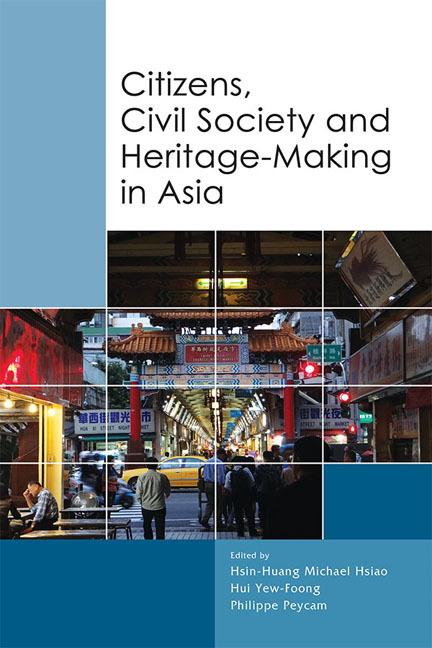Book contents
- Frontmatter
- Contents
- Contributors
- 1 Introduction: Finding the Grain of Heritage Politics
- 2 Heritage, Identity and Power
- 3 Heritage-Making and Post-coloniality in Yangon, Myanmar
- 4 Living Heritage of Ruins? Contesting the Paradox in Trowulan's Majapahit Heritage
- 5 The Reconstruction of Heritage in Rural Vietnam: An Analysis of State and Local Dynamics
- 6 Performing Cultures, Negotiating Identities: The Cultural Politics of Indigenous Cultural Villages in West Malaysia
- 7 Constituting Philippine Filmic and Linguistic Heritage: The Case of Filipino Regional Films
- 8 Encounter and Counter-Narratives of Heritage in Macau
- 9 Cultural Activities of the Chinese Community in Post-war Myanmar
- 10 Chinese Street Opera in Singapore: Heritage or a Vanishing Trade
- 11 Policy Formation and Civil Society Engagement in Heritage-Making in Taiwan: A Historical Examination
- 12 Becoming Taiwanese: Appropriation of Japanese Colonial Sites and Structures in Cultural Heritage-Making — A Case Study on the Wushantou Reservoir and Hatta Yoichi
- 13 Defining Culture in the Heritage Preservation of Taiwanese Veterans’ Villages: The Case of Zuoying
- 14 Tobacco Crop Memories in Taiwan: The Heritage of a Deadly Agriculture
- Index
9 - Cultural Activities of the Chinese Community in Post-war Myanmar
Published online by Cambridge University Press: 03 January 2018
- Frontmatter
- Contents
- Contributors
- 1 Introduction: Finding the Grain of Heritage Politics
- 2 Heritage, Identity and Power
- 3 Heritage-Making and Post-coloniality in Yangon, Myanmar
- 4 Living Heritage of Ruins? Contesting the Paradox in Trowulan's Majapahit Heritage
- 5 The Reconstruction of Heritage in Rural Vietnam: An Analysis of State and Local Dynamics
- 6 Performing Cultures, Negotiating Identities: The Cultural Politics of Indigenous Cultural Villages in West Malaysia
- 7 Constituting Philippine Filmic and Linguistic Heritage: The Case of Filipino Regional Films
- 8 Encounter and Counter-Narratives of Heritage in Macau
- 9 Cultural Activities of the Chinese Community in Post-war Myanmar
- 10 Chinese Street Opera in Singapore: Heritage or a Vanishing Trade
- 11 Policy Formation and Civil Society Engagement in Heritage-Making in Taiwan: A Historical Examination
- 12 Becoming Taiwanese: Appropriation of Japanese Colonial Sites and Structures in Cultural Heritage-Making — A Case Study on the Wushantou Reservoir and Hatta Yoichi
- 13 Defining Culture in the Heritage Preservation of Taiwanese Veterans’ Villages: The Case of Zuoying
- 14 Tobacco Crop Memories in Taiwan: The Heritage of a Deadly Agriculture
- Index
Summary
Heritage, community and identity remain “malleable” (Harvey 2001, p. 310) for scholars who have for years been investigating the meaning of the past (Graham and Howard 2008, p. 13). Nevertheless, it is generally agreed that things related to the past are open to interpretation and manipulation under the present political and social contexts, and it is an ever-changing, ongoing process (Harvey 2001, p. 320). “If heritage is constructionist and concerned with the selected meanings of the past in the present, this suggests that the past in general, and its interpretation as history or heritage, confers social benefits as well as potential costs in the construction and reproduction of identities” (Graham and Howard 2008, p. 5). Indeed, this particular ambiguity presents a unique opportunity to make and remake heritage “according to the needs of articulating and empowering” (Crooke 2010, p. 17), sometimes by individuals and communities at disadvantaged positions.
This chapter examines the formation, maintenance and recent development of the cultural heritage of the ethnic Chinese community in Yangon in the post-war era. It looks at two Yangon-based grass-roots institutions, a Classical Chinese poetry society and a Chinese language library, and follows their ups and downs throughout the eventful decades between the late 1940s and the present day. For an ethnic-minority, exmigrant community in a newly independent nation state that has been dominated by the indigenous majority, communal organizations like these have to walk a fine line to reconnect the ancestral past with a volatile and demanding present, in a balanced style through careful and conscious selections, and must constantly adjust their strategies. The heritagization of certain cultural practices not only established a relationship to the community's temporally and geographically remote, sometimes imaged, past, but also faithfully reflected the changing social environment of what was permitted and what was not. Furthermore, questions such as what is to be defined the community's cultural heritage and who has the authority to define it, have been negotiated over the years and are still open to debate. It is also worth pointing out that in post-war Myanmar the awareness of preserving heritage (heritage as we understand today) has been fairly limited if not non-existent among the cultural practitioners, and the most obvious driving force often came from contemporary geopolitical pressures and personal subscriptions.
- Type
- Chapter
- Information
- Citizens, Civil Society and Heritage-Making in Asia , pp. 185 - 207Publisher: ISEAS–Yusof Ishak InstitutePrint publication year: 2017

